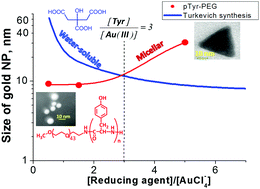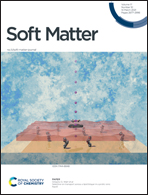Binding of chloroaurate to polytyrosine-PEG micelles leads to an anti-Turkevich pattern of reduction†
Abstract
Here we report formation of gold nanoparticles (GNPs) in micelles of polytyrosine-PEG copolymers that combine the properties of a reducer and a stabilizer. The size and properties of the GNPs were tailored by the excess chloroaurate over the copolymer. The latter quickly formed non-covalent complexes with HAuCl4 and then slowly reduced it to form GNPs. 3 Tyr residues are consumed by reduction of one mole of chloroaurate. The size of the GNPs was controlled by the [Tyr]/[Au(III)] molar ratio. Small GNPs with D ≅ 8 nm were formed at [Tyr]/[Au(III)] = 0.5–1.5. 90% of these small GNPs remained bound to the copolymer and could be stored in a lyophilized state. Such polypeptide–gold hybrid materials produced at [Tyr]/[Au(III)] = 0.5 demonstrated high activity in the catalytic reduction of 4-nitrophenol by sodium borohydride. [Tyr]/[Au(III)] = 5 led to the formation of large nanoplates (D ≅ 30–60 nm). Thus, in the polymer-based system the GNP size grew in line with the excess of the reducing agent in contrast to Turkevich synthesis of GNPs with citric acid, which also combines the functions of a stabilizer and a reducer. The difference results from the reduction of HAuCl4 in solution according to the Turkevich method and in the micelles of the amphiphilic polymer where the seed growth is limited by the amount of neighboring reducer.



 Please wait while we load your content...
Please wait while we load your content...